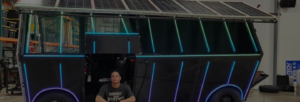Off-Grid Power – Air Conditioners Solar power and lithium battery technology have revolutionized the way...
Read MoreWhy High Efficiency Solar Cells offer the Best Value
Monocrystalline, polycrystalline and amorphous are terms used to describe solar products, but what do they mean? And more importantly, why are some solar panels better than others? Learning solar panel / module basics and the differences between solar cells, will help users understand the life expectancy, durability, efficiency and return on investment of their system.
A solar panel generates electrical power by converting the sun’s energy using a variety of photovoltaic (PV) cells. Learn more When sunlight hits a silicon solar cell, for example, an electrical current is produced because the electrons move when exposed to light. Depending on the quality and materials used to create the cell, the capability and efficiency of a solar module varies. Three popular solar cell types on the consumer market include: monocrystalline (mono), polycrystalline (poly) and amorphous (thin film).
Mono and Poly Modules
These are the most popular and widely used modules in RV solar kits and are found in Go Power!’s Solar Extreme, Solar Elite, Weekender, Overlander, Retreat and Eco kits. While polycrystalline solar cells are made by melting and pouring silicon into a mold, monocrystalline solar cells are thin wafers cut from a single continuous crystal grown specifically for this purpose. This makes the mono cell panel smaller and more efficient, which is especially ideal for RVs with limited roof space. Mono and poly panels provide the most power per square foot and are much more durable compared to thin films. These modules are most often constructed using rigid frames with tempered glass and standard tests have shown the ability to withstand 1″ hailstones at 51 mph (83 km/h). Recently, Go Power! introduced a flexible (non-framed) mono panel series, “Solar FlexTM“, combining the durability and efficiency of rigid panels with the versatile mounting options of thin films. These new Solar FlexTM (mono) panels use a “back contact” technology where the electrical wires run below the solar cell, therefore increasing the usable cell surface, making them more efficient. The new flexible panels can be slightly more expensive than other mono panels but are 82% lighter and durable enough to walk on. Mono and poly panels typically carry a warranty of 25 years (10 years for Solar FlexTM panels).
Amorphous or “thin film” Modules
Thin films, like the Go Power! SUNFilm battery chargers (discontinued), are less expensive than mono or poly modules, but are also less efficient and degrade much faster in the sunlight. They perform better in low light conditions and are an ideal choice for trickle charging batteries when RVs or other pleasure vehicles are sitting idle for long periods of time. Amorphous modules are created from a thin layer of silicon laid on either a rigid or flexible backing material. This allows the amorphous technology to be adapted for numerous applications from solar calculators to cell phone chargers. Warranties for these products vary between 1 and 10 years.
Solar cell efficiency
Cell efficiency is determined by the amount of light each solar cell converts to usable electrical power. This means that high-efficiency systems (using mono/poly modules) will generate more power with fewer panels. Lower efficiency modules (amorphous) will cover more roof to produce the same amount of power as high-efficiency modules and will reduce the maximum power output the rooftop can generate. When roof space and power demands are a prime concern for most RVers, considering the amount of power generation per square inch is a must, Mono or poly cells have almost double the efficiency of an amorphous cell. Fewer panels will also reduce installation time and costs, however thin film and flexible mono modules do have an added benefit of avoiding custom mounts on curved surfaces. Consumers will also benefit from modules with high cell efficiencies because they typically have much longer warranty periods. (Keep in mind that you will want to use solar from a reputable manufacturer who will be around to cover the warranty in 25 years!)
The Value of High-efficiency Solar
Mono and polycells are considered to be of the highest quality based on cell efficiency (17-20% vs. 10% for thin films) and warranty (25 years vs. 1-10 years for thin films). These solar panels may cost more than the thin films, but will ultimately generate more electricity in a lifetime and offer a long-term value. Solar kits should be viewed as a long-term investment. A quality solar panel should have little to no maintenance, be durable enough to withstand extreme weather conditions and provide a reliable power source to keep your batteries charged for decades. While the upfront purchase price is a major factor in determining what solar panel or kit to purchase, always consider how solar efficiency can help you maximize the overall return on investment.
LATEST NEWS
Watch product troubleshooting videos, read the latest in company updates, and stay up-to-date on trade-shows and events.
Creating the Ultimate Solar-Powered Car
Few people have a more diversified portfolio when it comes to custom car builds than...
Read MoreGo Power! Wins Gold in
Go Power! Wins Gold for Favorite RV Solar Product in the 2024 Wildsam Reader’s Choice...
Read More
STAY UP TO DATE
Get news, product specials, and event invites directly to your inbox.







